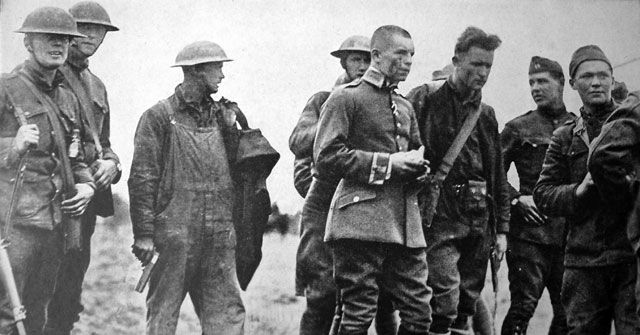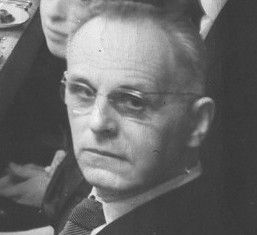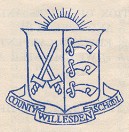|
Obituary
Some of you might remember an elderly Lab Assistant at the school in the late
50s and the 60s. His name was Dr. Marwede, although he might have
been known under a nickname. For those, who don't remember him or
only saw him in passing, after reading this obituary you will only envy those
who can claim to have known a really remarkable man. We have Tony Marshall
to thank for this copy of his obituary.
He was born in the district of
Steiglitz, Berlin, Germany. His father died when he was quite young
and he was brought up by his grandmother. Though not a particularly
happy arrangement his education did not suffer. He excelled in
physics, chemistry, mathematics and languages; achieving matriculation
distinctions at Berlin University. In 1916 he volunteered for the
German Army & Air Force and qualified as a fighter pilot. He was
decorated with the Iron Cross and service medals for 12 victories in the
air. Later he was himself shot down and badly injured, becoming a
prisoner-of-war under the Americans. He was repatriated during 1919.
Thereafter, until 1925 he studied at Berlin University, achieving a
doctorate and Ph.D. for research in electron emission and dielectric
constants of crystals along different optical axis. During this
period he was also technical assistant to Professors von Laue and Albert
Einstein for experimental work.
After leaving university he became director of several companies
specialising in optical and electrical equipment, also setting up his own
company to exploit projection apparatus for which he was granted patents
both in France and England. This and other activities brought him
into conflict with the Nazi regime and it became necessary for him to
leave Germany in 1934 and go to Paris where his company had a branch
office. He was able to carry on his business from there.
In 1937 he qualified as a gliding instructor under the French Ministry for
Aeronautics. In 1939 at the outbreak of the second world war, being
an alien, he was listed for internment but managed to get to Marseilles,
where in 1940, he volunteered for the French Foreign Legion and because of
his expertise he was made chief electrical engineer in Societe Fougerolles
in Rabat, Morocco. In 1943 the British Army in North Africa
recruited him and he accepted the job of vehicle and plant engineer in the
REME and served in this regiment throughout the Italian campaign.
He was finally demobbed in England when the war ended in 1945. This
enabled him to resurrect his business interests and he chose to become a
naturalised Englishman. After retiring, his interests in laboratory
work took him to a local grammar school until well after his 80th
birthday. His last years were spent in Southwick, England with a
long-standing friend. He was the last surviving Luftwaffe fighter
pilot from the first World War.
Thanks to
Pat Henson for putting together the following update:-
Henry
is now commemorated at the RAF Museum, Tangmere, West Sussex and you can check
him out on their website at
http://www.tangmere-museum.org.uk/artefact-month/he-fought-for-the-germans-and-the-british.
His flying exploits and subsequent downing and
capture are described elsewhere :-
Balloon Buster of WW1
:
On Sept 14,
1918, members of 33rd Division AEF, witnessed a French balloon shot down in
flames from the village square of Fromereville. The event was recorded by two
independent witnesses. One witness, Lt Will Judy, said the balloon was only
about 300 yards from the village square. Both witnesses report that the German
plane strafed the observer as he descended by parachute. Lt Judy reported that
the German plane flew off and immediately shot down a second balloon.
The German pilot was most likely Unteroffizier  Hans
Heinrich Marwede,
of Jagdstaffell 67, who was credited on Sept 14 with shooting down three
balloons in a space of five minutes, at about 4:35 in the afternoon, southwest
of Verdun. (Fromereville is just over 7 kilometers west of Verdun). Hans
Heinrich Marwede,
of Jagdstaffell 67, who was credited on Sept 14 with shooting down three
balloons in a space of five minutes, at about 4:35 in the afternoon, southwest
of Verdun. (Fromereville is just over 7 kilometers west of Verdun).
(To be fair to Henry, it appears that balloon observers were considered to be
fair game by both sides ! ed.)
See :
http://www.theaerodrome.com/forum/other-wwi-aviation/54762-french-balloon-units-west-verdun-sept-1918-a.html.
After serving
with Kest 2, Marwede joined Jasta 67 in 1918 and was credited with shooting down
a
D.H.9
and four balloons. On 3 October 1918, he flamed an American balloon southwest of
Montfaucon only to be shot down by anti-aircraft fire.
See
picture below – a different Henry to the one we came to know later on in his
life.

Henry joined
Willesden County Grammar in 1956 and was a familiar figure around the school as
he went about his work as lab technician. However, he had other interests that
were shared with the pupils :
The Table
Tennis Club : Henry was himself a pretty good player and ran a club after school
in the store room near to the changing rooms for field sports.
Table Tennis
& Cars as recalled by Colin Twyford (a friend of Henry) :
I was
prompted to google Henry Marwede by a Question in the Daily Mail on April 8th
2013 about Germany’s Jewish aces and found an obituary published by Tony
Marshall. In the early 1950s’ I joined Moreshead Tennis Club, London near
Paddington, the table tennis section was organised by Henry, he had a garage
fairly close to the club with a small flat above where he often stayed when
working on cars. Some of us bought an old American car just before petrol
rationing came in and as it only did 12 MPG we laid it up opposite his garage
and I had a go at de-coking (first time). He told me of his First War
experiences, his projection company and his later Royal Engineers stint in the
Second War. He was a wonderful and thoughtful man and I was privileged to know
him.
More on cars
as recalled by Bob Crundwell (1959-66)
We both had Austin Sevens but mine ran ! His was in bits distributed around the
school. We often compared notes on them. I recollect bits of his car in the
greenhouse? in one of the small Quads between the two back corridors - it was
very dismantled !

The
quite unique Henry Marwede as we knew him at Willesden County Grammar School!
|
